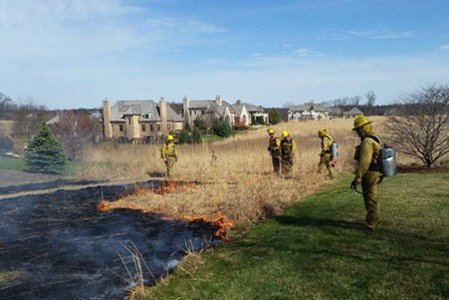
Controlling invasive plant species is a year-round battle. While many of the herbaceous invasives are best tackled in spring and summer, winter is the ideal time to target woody species such as autumn olive, buckthorn, and Asian bush honeysuckle.
Depending on species, property type, budget, and other considerations, there are many ways to keep woody invasive plants in check. There are many ways to attack this problem:
Winter Invasive Plant Control Methods
Cut Stump Treatment – This method utilizes a chainsaw to fell individual trees and works well for anything from 1” saplings to mature trees. The stump is then treated with herbicide to prevent regrowth.
Cutting with a Brushcutter – For stands of smaller trees and shrubs up to 2-3” in diameter, a brushcutter can be a quicker option. You might have to bring in a chainsaw to take out the larger trees. This method also requires treating the stumps with herbicide.
Forestry Mulching – A forestry mulcher or mower is essentially a skid steer with a large rotating cylinder on the front. It will handle thick brush and even trees up to 6”DBH, turning them into a pile of chips. For properties with a lot of woody material to be removed, this can be a very efficient and cost-effective method. It is fast, labor-saving, and eliminates the need for brush removal from the property.
Girdling – Where larger single trees need to be killed but left standing, girdling is a cost-effective method. A chainsaw is used to cut a ring around the outside of the tree at waist height, ½” into the cambium of the tree. Herbicide is applied to the wound, killing the tree over time. This method is cost-effective but is inadvisable for public or heavily utilized properties due to the hazards of standing dead wood.
Hack and Squirt – A similar method is to take a small hatchet and hack a circle of wounds at the base of the tree or shrub, then squirt herbicide into the wounds to kill the tree. This method works well for invasive shrubs like buckthorn and Asian bush honeysuckle.
Basal Bark Treatment – Here, the herbicide is used directly on the trunk of the tree without cutting through the bark. Typically, the bottom 18-24” of the tree is sprayed with a combination of Garlon 4 (oil-soluble triclopyr) and basal oil, which soaks in and kills it. It doesn’t work for every species but can be useful in certain circumstances. One of these is controlling Tree of Heaven since exposure to the sap of this tree has been linked to risk of heart conditions.
Prescribed Burning – Controlled burning of a site can also be an effective way to control both woody and herbaceous invasives on certain sites since invasive plants come up sooner in the spring than natives and have shallower root systems. Burns must be timed correctly to target invasives without harming native species.
Are Herbicides Necessary?
Any time woody materials are cut it is recommended to treat the wounds with herbicide quickly, applying it directly to the cambium layer of the plant. Not treating the wound will allow new sprouts to emerge during the following growing season. Aggressive, invasive species can quickly recover, rendering control efforts useless and/or adding greatly to the cost of treatment.
Most of the above methods do require the use of herbicides to achieve effective results. However, winter application allows for very targeted treatment, minimizing herbicide use by concentrating it only where it needs to go and limiting off-target damage to nearby plants. It takes far less herbicide to apply around the edge of a stump or hack and squirt around the base of a dormant tree than to spray an entire tree in leaf.
It is important to use herbicides responsibly. Make sure you are using products rated for the habitat in question. For instance, wetland projects must utilize water safe chemicals (such as water safe forms of triclopyr) to avoid adverse effects to fish, amphibians, and invertebrates inhabiting the ecosystem. Also, if you are treating in sub-freezing conditions, choose an herbicide that contains an antifreeze agent, such as Pathway RTU or oil-based triclopyr.
Planning for Winter Invasive Plant Control
Whether you are interested in restoring a native plant community, looking to meet regulatory requirements for wetland permitting, or simply want to keep the brush on your property under control, fall and winter are great times to plan your offense against invasives. By assessing your site requirements, types of species, and budget, we can help you create the right invasive plant control plan for your property.



